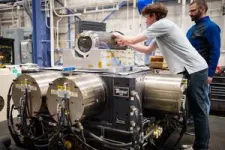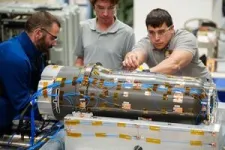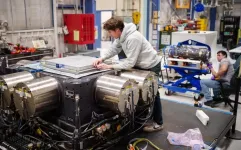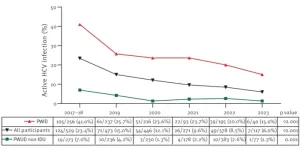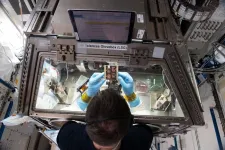(Press-News.org) CORVALLIS, Ore. – Researchers at Oregon State University have developed a material that shows a remarkable ability to convert sunlight and water into clean energy.
A collaboration led by Kyriakos Stylianou of the OSU College of Science created a photocatalyst that enables the high-speed, high-efficiency production of hydrogen, used in fuel cells for cars as well as in the manufacture of many chemicals including ammonia, in the refining of metals and in making plastics.
The findings represent a potential new tool to use against greenhouse gas emissions and climate change, said Stylianou, whose research focuses on crystalline, porous materials known as metal organic frameworks, usually abbreviated as MOFs.
Made up of positively charged metal ions surrounded by organic “linker” molecules, MOFs have nanosized pores and tunable structural properties. They can be designed with a variety of components that determine the MOF’s properties.
In this study, researchers used a MOF to derive a metal oxide heterojunction – a combination of two materials with complementary properties – to make a catalyst that, when exposed to sunlight, quickly and efficiently splits water into hydrogen.
The heterojunction, which they refer to as RTTA, features MOF-derived ruthenium oxide and titanium oxide doped with sulfur and nitrogen. They tested multiple RTTAs with different amounts of the oxides and found a clear winner.
“Among various RTTA materials, RTTA-1, with the lowest ruthenium oxide content, exhibited the fastest hydrogen production rate and a high quantum yield,” Stylianou said.
In just one hour, he noted, a gram of RTTA-1 was able to produce over 10,700 micromoles of hydrogen. This process utilized photons—light particles—at an impressive rate of 10%, meaning that for every 100 photons that struck RTTA-1, 10 contributed to hydrogen production.
“The remarkable activity of RTTA-1 is because of the synergistic effects of the metal oxides’ properties and surface properties from the parent MOF that enhance electron transfer,” Stylianou said. “This study highlights the potential of MOF-derived metal oxide heterojunctions as photocatalysts for practical hydrogen production, contributing to the development of sustainable and efficient energy solutions.”
Producing hydrogen by splitting water through a catalytic process is cleaner than the conventional method of deriving hydrogen from natural gas via a carbon-dioxide-producing process known as methane-steam reforming.
Current catalytic processes for producing hydrogen from water involve electrocatalysis – running electricity through the catalyst. The sustainability of electrocatalysis depends on using renewable energy, and to be competitive in the market the energy has to be inexpensive.
Presently, methane-steam reforming produces hydrogen at a cost of about $1.50 per kilogram, compared to about $5 a kilogram for green hydrogen.
“Water is an abundant source of hydrogen, and photocatalysis offers a method to harness the Earth’s abundant solar energy for hydrogen production,” Stylianou said. “Ruthenium oxide is not cheap but the amount used in our photocatalyst is minimal. For industrial applications, if a catalyst shows good stability and reproducibility, the cost of this small amount of ruthenium oxide becomes less important.”
The College of Science, the college’s Department of Chemistry, and retired public school teachers and OSU alumni Brian and Marilyn Kleiner provided funding for the research, which was published in Angewandte Chemie.
The project was led by graduate students Emmanuel Musa, Ankit Yadav and Kyle Smith, and involved collaboration with included Xiulei “David” Ji, professor of chemistry at OSU; Peter Eschbach, director of the Electron Microscopy Facility at Oregon State’s Linus Pauling Science Center; postdoctoral researcher Min Soo Jung; and courtesy faculty member William Stickle.
END
Oregon State University research uncovers better way to produce green hydrogen
2024-07-25
ELSE PRESS RELEASES FROM THIS DATE:
Transforming environmental testing one shake at a time
2024-07-25
ALBUQUERQUE, N.M. — Testing weapons and components in a lab-controlled environment has always been at the center of Sandia National Laboratories’ mission. Since the U.S. stopped underground explosives tests on weapons in the early 1990s, Sandia has developed other methods to conduct experiments that mimic the range of environments a weapons unit might experience. A newly developed method is getting better results, with fewer tests, in less time.
“Our job in the laboratory is to simulate the environment and lifetime of stress ...
Midwestern launches public research profiles through Symplectic Elements
2024-07-25
Digital Science, a technology company serving stakeholders across the research ecosystem, is pleased to share the news that Midwestern University has successfully launched a new faculty profiles portal powered by Symplectic Elements.
Midwestern has been utilizing Symplectic Elements as its Research Information Management System since 2019, and has made the decision to expand its use by adding public profiles. The faculty profiles repurpose the comprehensive data already within Elements to populate enhanced profiles, including biographical information as ...
Accelerating motor neurone disease research by harnessing the power of health data
2024-07-25
MND is a devastating disease affecting the motor neurones in the brain and spinal cord, leading to progressive muscle weakness and paralysis. Despite decades of research, several scientific challenges continue to impede the development of effective therapies for the thousands of people living with MND in the UK.
The MND Research Data Catalyst is a new initiative led by HDR UK and DPUK, with the UK Dementia Research Institute (UK DRI) and in partnership with the MND research community, to accelerate the discovery of new diagnostics, treatments and support better care for MND patients. This will be achieved by harnessing the UK’s trustworthy, large-scale health ...
World Hepatitis Day 2024: Madrid study shows decrease in active hepatitis C infection among risk groups, indicating effectiveness of public health measures
2024-07-25
A study conducted through a mobile screening unit in Madrid, Spain from 2017 to 2023 and published in Eurosurveillance found that active hepatitis C virus (HCV) infection decreased from 23% to 6% in that period among people who use drugs (PWUD) that visited the unit. The study found that the use of intravenous drugs was the most significant risk factor for infection among PWUD. It confirmed that HCV screening and treatment programmes targeting this at-risk population are effective and can help achieve the World Health Organization goal of HCV elimination as public health threat by 2030.
Study participants and methods
Participants were recruited in ‘hotspots’ ...
After Trump’s election, women of color had more underweight, premature babies, study finds
2024-07-25
In 2016, President-elect Donald Trump vowed to deport thousands of immigrants. His anti-immigration message vilified foreign-born people living in the U.S. as criminals and rapists. Besides making good on many harsh, immigration-related promises, the years after his election stoked the anxieties of millions of people.
Now, with Trump once again in contention for the White House, a new study from the University of California, Berkeley, reveals the surprising — and potentially lifelong — association between those early Trump years and the health of society's newest citizens.
In ...
Space-trekking muscle tests drugs for microgravity-induced muscle impairment
2024-07-25
A gentle rumble ran under Ngan Huang’s feet as a rocket carrying her research—live, human muscle cells grown on scaffolds fixed on tiny chips—lifted off, climbed, and disappeared into the sky to the International Space Station National Laboratory. These chips would help Huang better understand muscle impairment, often seen in astronauts and older adults, and test drugs to counter the condition.
Now, the results are back. Reporting in a study published July 25 in Stem Cell Reports, Huang’s team showed that space-travelling muscle had metabolic changes that indicate ...
In clinical trial, fecal matter transplant helped half of patients with gastrointestinal cancers overcome resistance to immunotherapy treatment
2024-07-25
Findings from a small, proof-of-concept clinical trial have suggested that fecal microbiota transplants (FMTs) can boost the effectiveness of immunotherapy in a range of gastrointestinal cancers. In the study, published July 25 in the journal Cell Host & Microbe, six of 13 patients who had previously shown resistance to immune checkpoint inhibitors benefited from receiving FMTs from donors who had previously responded to treatment. The investigators also identified specific strains of bacteria associated with better or worse responses to FMT and immune checkpoint drugs.
“This research highlights the complex interplay between beneficial ...
Royal Ontario Museum scientist identifies Great Salt Lake as a significant source of greenhouse gas emissions
2024-07-25
Newly announced research by Royal Ontario Museum (ROM) examining greenhouse gas emissions from the drying lake bed of Great Salt Lake, Utah, calculates that 4.1 million tons of carbon dioxide and other greenhouse gases were released in 2020. This research suggests that drying lake beds are an overlooked but potentially significant source of greenhouse gases, which may further increase due to climate change. These results were announced in the paper, “A desiccating saline lake bed is a significant source of anthropogenic greenhouse gas emissions,” published in the journal One Earth.
“Human-caused ...
Provision of stroke care services by community disadvantage status
2024-07-25
About The Study: Hospitals in communities with the greatest level of socioeconomic disadvantage had the lowest likelihood of becoming stroke certified while hospitals in the most advantaged communities had the highest likelihood in this cohort study. These findings suggest that there is a need to support hospitals in disadvantaged communities to obtain stroke certification as a way to reduce stroke disparities.
Corresponding Author: To contact the corresponding author, Renee Y. Hsia, M.D., M.Sc., email renee.hsia@ucsf.edu.
To access the embargoed study: Visit our For The Media website at this link ...
Bilateral mastectomy and breast cancer mortality
2024-07-25
About The Study: This cohort study indicates that the risk of dying of breast cancer increases substantially after experiencing a contralateral breast cancer. Women with breast cancer treated with bilateral mastectomy had a greatly diminished risk of contralateral breast cancer; however, they experienced similar mortality rates as patients treated with lumpectomy or unilateral mastectomy.
Corresponding Author: To contact the corresponding author, Steven A. Narod, M.D., email steven.narod@wchospital.ca.
To access the embargoed study: Visit our For The Media website at this link https://media.jamanetwork.com/
(doi:10.1001/jamaoncol.2024.2212)
Editor’s ...

